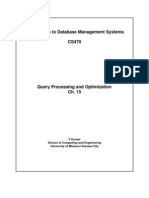Leonardo Electronic Journal of Practices and Technologies Issue 2, January-June 2003
ISSN 1583-1078 p. 20-36
SQL by Example. 1.
Application for High School Bachelor Examination
Lorentz JÄNTSCHI
a
Technical University of Cluj-Napoca, Romania, http://lori.academicdirect.ro
Abstract
This paper main objective is to present SQL power of use of data management
with heterogeneous cases of data classification. The article is based on a PHP
application developed to manage a real situation of school-leaving examination
in August 2003 at Braşov city, Romania at exams center no. 29, where the first
author was president of the committee of the examination. The paper describes
all used queries that was used for classifications, room repartitions, probes and
investigation subject envelopes and finally, describe de final classification
algorithm.
Keywords
SQL application, MySQL database server, PHP programming.
Introduction
Main information about the school-leaving examination is required.1 The examination
is organized into Exam Centers, where participate candidates form more than one school (in
presented case 12 schools) with varied specializations (in our case 12 specializations). Note
that one school has in most of cases candidates with more than one specialization (in our case
from 1 to 5). For example, produce 5 rows a query like:
20
http://lejpt.academicdirect.ro
� SQL by Example. 1. Application for High School Bachelor Examination
Lorentz JÄNTSCHI
SELECT DISTINCT `pl` FROM `candidati` WHERE `sc` LIKE 'N. Titulescu'
School-leaving examination is organized by probes. All candidates that were studied
in Romanian language in school must sustain 6 probes. For the candidates that were studied in
mother tongue in school must sustain 8 probes. Probes are 2 (or three, respectively)
eliminatory and are viva voce and the candidates obtains a qualifying result for every probe
(one from: admitted, discarded and not present). The `a` probe is obligatory for all candidates
and is Romanian language and literature. The `c` probe is for candidates with mother tongue
in school. According to candidate specialization for the last three probes, the candidates has
option to sustain at every probe the exam at one discipline from a list of one or more
disciplines at partial free chousing (as example, if candidate specialization is philology, the
candidate can sustain `b` probe at one modern language, and at `e` probe must sustain the
exam at the other one language according to his school studies. For example, in our case, for
`b` probe, we have three modern languages, that result from select phrase:
SELECT DISTINCT `pb` FROM `candidati`
After the eliminatory probes (2 or 3) all candidates are allowed to participate at rest of
the probes (4 or 5). These probes are noted with marks from 10.00 to 1.00.
To promote school-leaving examination, candidate must pass the eliminatory probes (with
admitted qualification) and must have mark of at least 5.00 for every other ones probes. More,
two decimals chopped average mean of all noted with marks probes must be at least 6.00.
A database to store all required information is necessary. More, with PHP2 in
conjunction with MySQL3 a set of programs to process efficiently the information the task is
fast and efficient.
Database Design
A database called Bac2003 with a set of 16 tables was created (see fig. 1).
Because a set of varied number from 2 to 6 Exam Center (EC) are goes to one Zonal
Center of Evaluation (ZCE) where all hand writes exam papers are evaluated and marked (`a`
and `c` probes, and some disciplines from `e` and `f` probes) the database are designed to
manage all exam results from more than one EC (as example, all EC depended at one ZCE).
21
� Leonardo Electronic Journal of Practices and Technologies Issue 2, January-June 2003
ISSN 1583-1078 p. 20-36
The table `ex` is used for both user management and EC classification. It store in `id`
field the identification number of EC (in our case from 29 to 34), in field `nume` the name of
operator (usually one of the EC committee members) and his password. Note that for this
table `id` is not a primary key, but using a SELECT DISTINCT SQL phrase we have a
column that act as primary key for `ex`, `candidati` and `scoli` tables. More, from here it
result as consequence that for an EC we can have more than one operator. There exists a super
user for user management, with a blank `id` key. A script for user management was created.
The script use three SQL phrases, one for SELECT, one for INSERT and one for UPDATE in
table `ex`.
ex candidati sc
id ex ex
nume sc nume
password abs id
id
abs pg pg
nume nume id
pl nume
pl pa
id ra pa
nume ca id
pb nume
pb rb
id cb pc
nume pc id
rc nume
c cc
id pas pas
nume ras id
nas nume
pcs pcs
id rcs pd
nume ncs id
pd nume
pf rd
id nd pe
nume pe id
re nume
ne
pf r
rf id
nf nume
Figure 1. Bac2003 database architecture
22
� SQL by Example. 1. Application for High School Bachelor Examination
Lorentz JÄNTSCHI
For example, the phrase which and add a new operator at $HTTP_POST_VARS['id']
EC with $HTTP_POST_VARS['nume'] name and $HTTP_POST_VARS['password']
password is:
INSERT INTO `ex` VALUES ( '$HTTP_POST_VARS['nume']', '$HTTP_POST_VARS['id']',
PASSWORD('$HTTP_POST_VARS['password']') )
Table `sc` stores the names of schools (`name` field, candidate key), EC number (`ex`
field, foreign key) and primary key (`id` field, auto increment). Table `abs` contain only
`nume` field that stores school graduation years (from 2003 descending) which act as primary
key also. Table `pg` store only two values to discriminate the study curricula of the candidates
(candidates from 2003 school graduation year with 12 graduation years has one type of
curricula, and the all others, i.e. previously graduated candidates and 2003 graduated
candidates with 13 graduation years).
Table `pl` store profiles of studies (such as philology, economics, and so on, 12
distinct profiles in our case). The `id` field is primary key and `nume` field is the candidate
key. The tables `pa`, `pb`, `pc`, `pas`, `pcs`, `pd`, `pe` and `pf` contains the names and the
primary keys for the disciplines by probes, every table storing all possible disciplines of one
probe. The table c contain the labels and primary keys of qualification marks (i.e. 'adm.' for
admitted, 'res.' for not admitted, and 'nep.' for not presented).
Table `candidati` is designed to store all information about candidates. A script to
store the primary information (candidate name) was designed and called candidats.php. The
candidats.php program makes INSERT candidates in table `candidati` successively for an EC
by provenience schools. The required information is candidate’s names and inserted
information is composed from `id` (primary key), `nume` (candidate first and second name,
not necessary candidate key), `ex` (EC, foreign key from `ex` table) and `sc` (provenience
school, foreign key from `sc` table).
The second step is to fill all others information about candidates into candidate records
(defined by `id` key). A set of PHP programs was prepared for this task. The program
query.php retrieves from `candidati` table for selected candidates a set (one or more fields) of
information and, for every field (excepting `nas`, `ncs`, `nd`, `ne`, `nf` fields) create a combo
box with all possible values from primary tables (see fig. 1). Then, the candidate’s registration
procedure is fast and easy. More, the program can be executed any time for updates or
23
� Leonardo Electronic Journal of Practices and Technologies Issue 2, January-June 2003
ISSN 1583-1078 p. 20-36
eventually corrections. The program do.php verifies the updates and for not empty values
makes UPDATE at `candidati` table.
Problems and Solutions
The problems that appear in school-leaving examination procedure are produced by
the complexity of examination methodology.
First, the candidates must provide a list with options for every partial free selection
examination probe (for example, the candidates with humanistic profiles, i.e. philology, social
sciences, and so on can choose one of two options: Geography or History for `d` probe in the
mean while candidates with realistic profiles don’t have options, the examination at `d` probe
is from Mathematics, but depending on profile, graduation year, and type of study curricula,
resulting 6 types of subjects of Mathematics). More, for all probes, the control key for correct
options is candidate profile, graduation year and study curricula.
At the beginning of the school-leaving examination period, it must displayed a list
with all candidates and there options alphabetically sorted. Once we have `Bac2003` database,
a SELECT command is enough:
SELECT * FROM `candidati` WHERE `ex` LIKE '29' ORDER BY `nume` ASC
To format data on page, following script additions in PHP program are proper:
<style>.lori{text-align:center;font: Bold 8pt. Times New Roman;}</style>
<br clear=all style='mso-special-character:line-break; page-break-before:always'>
where style are used to display data in a table and page break are inserted after n=20
candidates.
For the first day of school-leaving examination (SLE), a list with all candidates which
must sustain `a` eliminatory probe must be provided, in same alphabetically order for time
scheduling and room repartitions:
SELECT `id`, `nume`, `ex`, `sc`, `abs`, `pg`, `pl`, `pa` FROM `candidati`
WHERE `ex` LIKE '29' AND `ra` LIKE '' ORDER BY `nume` ASC
24
� SQL by Example. 1. Application for High School Bachelor Examination
Lorentz JÄNTSCHI
Also, for verification, a list with candidates that has `a` probe recognized prom
previous sessions, but sorter first by school and second by name is very useful:
SELECT `id`, `nume`, `ex`, `sc`, `abs`, `pg`, `pl`, `pa`, `ra`, `ca` FROM `candidati`
WHERE `ex` LIKE '29' AND `ra` LIKE 'd' ORDER BY `sc` ASC, `nume` ASC
At the end of `a` probe, after the updating of the database, a list with admitted
candidates is:
SELECT `id`, `nume`, `ex`, `sc`, `abs`, `pg`, `pl`, `pa`, `ra`, `ca` FROM `candidati`
WHERE `ex` LIKE '29' AND `ra` LIKE '' AND `ca` LIKE 'adm.' ORDER BY nume`
The not present candidates are:
SELECT `id`, `nume`, `ex`, `sc`, `abs`, `pg`, `pl`, `pa`, `ra`, `ca` FROM `candidati`
WHERE `ex` LIKE '29' AND `ra` LIKE '' AND `ca` LIKE 'nep.' ORDER BY `nume`
The not admitted candidates are:
SELECT `id`, `nume`, `ex`, `sc`, `abs`, `pg`, `pl`, `pa`, `ra`, `ca` FROM `candidati`
WHERE `ex` LIKE '29' AND `ra` LIKE '' AND `ca` LIKE 'res.' ORDER BY `nume`
Before the beginning of `b` probe, a list with all candidates that must sustain this
probe, ordered by discipline and by name must be generated:
SELECT `id`, `nume`, `ex`, `sc`, `abs`, `pg`, `pl`, `pb` FROM `candidati` WHERE
`ex` LIKE '29' AND `ca` LIKE 'adm.' AND `rb` LIKE '' ORDER BY `pb`, `nume`
For verifications, the candidates with `b` probe recognized from previous sessions are
obtained from:
SELECT `id`, `nume`, `ex`, `sc`, `abs`, `pg`, `pl`, `pb`, `rb`, `cb` FROM `candidati`
WHERE `ex` LIKE '29' AND `rb` LIKE 'd' ORDER BY `nume` ASC
After updating the database with `b` probe results, the list of all candidates that can
sustain following probes is:
SELECT * FROM `candidati` WHERE `ex` LIKE '29' AND `ca` LIKE 'adm.'
AND `cb` LIKE 'adm.' ORDER BY `nume` ASC
25
� Leonardo Electronic Journal of Practices and Technologies Issue 2, January-June 2003
ISSN 1583-1078 p. 20-36
For candidates with mother tongue studies the `c` probe is necessary and eliminatory:
SELECT `id`, `nume`, `ex`, `sc`, `abs`, `pg`, `pl`, `pc` FROM `candidati` WHERE
`ex` LIKE '29' AND `pc` NOT LIKE '' AND `rc` LIKE '' ORDER BY `pc`, `nume`
The candidates with recognized results at `c` probe from previous sessions are:
SELECT `id`, `nume`, `ex`, `sc`, `abs`, `pg`, `pl`, `pc`, `rc`, `cc` FROM `candidati` WHERE
`ex` LIKE '29' AND `pc` NOT LIKE '' AND `rc` LIKE 'd' ORDER BY `pc` ASC, `nume` ASC
After the finishing of viva voice eliminatory probes, all accepted candidates for
following probes are:
SELECT * FROM `candidati` WHERE `ex` LIKE '29' AND `ca` LIKE 'adm.' AND
`cb` LIKE 'adm.' AND (`cc` LIKE 'adm.' OR `pc` LIKE '') ORDER BY `nume` ASC
Concordant with `a`, `b` and `c` results and previous sessions results, the list of
candidates for `as` probe are:
SELECT `id`, `nume`, `ex`, `sc`, `abs`, `pg`, `pl`, `pas` FROM `candidati` WHERE `ex` LIKE '29'
AND `ca` LIKE 'adm.' AND `cb` LIKE 'adm.' AND (`cc` LIKE 'adm.' OR `pc` LIKE '')
AND `ra` LIKE '' ORDER BY `nume` ASC
Room’s repartition of candidates for `as` probe is obtained from limit clause:
SELECT `id`, `nume`, `ex`, `sc`, `abs`, `pg`, `pl`, `pas` FROM `candidati` WHERE `ex` LIKE '29'
AND `ca` LIKE 'adm.' AND `cb` LIKE 'adm.' AND (`cc` LIKE 'adm.' OR `pc` LIKE '')
AND `ra` LIKE '' ORDER BY `pg`, `nume` LIMIT 0,20
and so on (LIMIT 20, 20, …) until all candidates are fetched (for rooms by 20 places).
For all following probes, the list of disciplines for which exam subjects are necessary
are required. The list for `cs` disciplines is:
SELECT DISTINCT `pcs` FROM `candidati` WHERE `ex` LIKE '29'
AND `ca` LIKE 'adm.' AND `cb` LIKE 'adm.' AND (`cc` LIKE 'adm.' OR `pc` LIKE '')
AND `rcs` LIKE '' AND `pcs` NOT LIKE '' ORDER BY `pcs`
Analogue, for `d`, `f` and `e` probe disciplines lists are obtained from previous select
phrase by replacing of `cs` with `d`, `e` and `f` respectively.
26
� SQL by Example. 1. Application for High School Bachelor Examination
Lorentz JÄNTSCHI
Room’s repartitions for `cs` mother tongue writes probe:
SELECT `id`, `nume`, `ex`, `sc`, `abs`, `pg`, `pl`, `pcs` FROM `candidati` WHERE `ex` LIKE '29'
AND `ca` LIKE 'adm.' AND `cb` LIKE 'adm.' AND `cc` LIKE 'adm.' AND `rcs` LIKE ''
ORDER BY `pl` ASC, `nume` ASC
Candidates with `cs` recognized probe:
SELECT `id`, `nume`, `ex`, `sc`, `abs`, `pg`, `pl`, `pcs`, `rcs`, `ncs` FROM `candidati`
WHERE `ex` LIKE '29' AND `ca` LIKE 'adm.' AND `cb` LIKE 'adm.' AND `cc` LIKE 'adm.'
AND `rc` LIKE 'd' ORDER BY `pl` ASC, `nume` ASC
Candidates for `d` probe:
SELECT `id`, `nume`, `ex`, `sc`, `abs`, `pg`, `pl`, `pd` FROM `candidati` WHERE `ex` LIKE '29'
AND `ca` LIKE 'adm.' AND `cb` LIKE 'adm.' AND (`cc` LIKE 'adm.' OR `pc` LIKE '')
AND `rd` LIKE '' ORDER BY `pd` ASC, `pg` ASC, `nume` ASC
Candidates for `f` probe are split in two, because 'EdF' and 'EdF-v' probes (sport) are
practically:
SELECT `id`, `nume`, `ex`, `sc`, `abs`, `pg`, `pl`, `pf` FROM `candidati` WHERE `ex` LIKE '29'
AND `ca` LIKE 'adm.' AND `cb` LIKE 'adm.' AND (`cc` LIKE 'adm.' OR `pc` LIKE '')
AND (`pf` LIKE 'EdF%') AND `rf` LIKE '' ORDER BY `pf` ASC, `pg` ASC, `nume` ASC
for sport and for all others are replaced (`pf` LIKE 'EdF%') clause with (`pf` NOT LIKE
'EdF%').
For `e` probe, is possible to have practical tests, such as in our case. The practical
disciplines are 'StFor' and 'Instr' so the previous select must be updated as follows:
• for 'StFor' (picture): `f` replaced with `e` in `pf` and `rf` and 'EdF%' replaced with
'StFor';
• for 'Instr' (music): `f` replaced with `e` in `pf` and `rf` and 'EdF%' replaced with 'Instr';
• for all others: `f` replaced with `e` in `pf` and `rf` and (`pf` NOT LIKE 'EdF%') replaced
with ((`pf` NOT LIKE 'StFor') OR (`pf` NOT LIKE 'Instr'));
27
� Leonardo Electronic Journal of Practices and Technologies Issue 2, January-June 2003
ISSN 1583-1078 p. 20-36
Implementation, Results and Discussion
To make required lists, all that we have to do is to submit queries to the SQL server
(in our case MySQL) and to fetch the results. One solution is to create a drop down list with
all SQL phrases for selection and more, for room repartition to create two input boxes for start
value and limit value from LIMIT clause. Probably is the best option.
Because the program was created and completed in school-leaving examination period
from 17 august to 29 august 2003 and the real situation was not known before the designed
interface is adaptive one that allow user to construct SQL phrases. Note that is not a perfect
one, because do not consider the `c` mother tongue possibly eliminated candidates
(conditional OR in SELECT). Anyway, for a small number of mother tongue candidates it
works perfectly.
The database management was makes on PHPTriad4 under Windows XP, because the
unavailability of internet connection, and after the school-leaving examination the database
and the programs was ported into a FreeBSD operating system with Apache web server. The
entry can be found at the address: http://vl.academicdirect.org/admittance_app/Bac2003_BV/.
If we enter into a phpMyAdmin5 web interface, database structure is displayed as in figure 2.
The action allowed (fig. 2) is to select the EC (C.E. noted in figure) and the action
(select, update, add schools, add candidates, add profile, make means). For select action, a
menu like in fig. 3 is displayed. The entry interface is password restricted, as we described in
figure 3.
First list is field list (<select multiple name='fields[]' size='$cols_n'>) a header
message follow, then filter list (up to 5 filters), then ordering criterions (up to 5, order is
strict), a footer message, a drop down list to draw supplementary columns (from 0 to 4) in
resulted table for supplementary information like time scheduling, room, marks, exam paper
serial number.
28
�SQL by Example. 1. Application for High School Bachelor Examination
Lorentz JÄNTSCHI
Figure 2. phpMyAdmin web interface to database structure
Figure 3. Bac2003 entry point
29
� Leonardo Electronic Journal of Practices and Technologies Issue 2, January-June 2003
ISSN 1583-1078 p. 20-36
Figure 4. SELECT phrase construction
Both filter and order drop down lists contain all fields from `candidati` table and was
retrieved using another SQL phrases:
SHOW COLUMS FROM `candidati` and SHOW TABLES FROM `Bac2003`
The update interface is designed as in fig. 5:
30
� SQL by Example. 1. Application for High School Bachelor Examination
Lorentz JÄNTSCHI
Figure 5. UPDATE phrase construction
Final Reports
At the end of school-leaving examination period, the final results must be provided. A
registration book leaf with all candidates ordered by name containing probe results is the final
document of examination.
The document it contain also average mean of the candidates for the candidates which
obtain at least minimum requirement marks for all probes.
To succeed the school-leaving examination the average mean must be at least 6.00. More, a
qualifying label are assigned to every candidate, one from `reusit` (for succeeded school-
leaving examination candidates), `respins` (for not succeeded school-leaving examination
candidates) and `neprezentat` (for not present candidates at one or more probes). The average
mean and qualification label require a program to computes. A program called media.php was
build. The program manages also the registration book leaf extracts by provenience schools
(for diplomas elaboration). So, the select phrase are again from user interface constructed (fig.
6).
31
� Leonardo Electronic Journal of Practices and Technologies Issue 2, January-June 2003
ISSN 1583-1078 p. 20-36
Figure 6. Means and qualifying labels presetting interface
The SELECT phrase is constructing dependent of the filter (page break filter)
selection:
SELECT * FROM `candidati` ORDER BY $sc `nume` ASC
where $sc can have a empty value or $sc="`sc` ASC, `".
MySQL query and fetch sequence is:
$q=mysql_query($query);
while($r=mysql_fetch_array($q)){
…
}
where $query it contain the SELECT phrase as string, $q is MySQL handler for fetching
management and $r is an object oriented array with elements constructed from MySQL
database. Every fetching produce a updating of $r values, that is $r['name'] is candidate name,
$r['sc'] is provenience school and so on.
A variable called $media was used to store the average mean value and a variable
called $c was used to store qualifying label. To avoid the errors produced by floating point
approximations and to display the mean with first two decimals some artifices are applied:
32
� SQL by Example. 1. Application for High School Bachelor Examination
Lorentz JÄNTSCHI
$media=($r['nas']+$r['ncs']+$r['nd']+$r['ne']+$r['nf'])*100;
//collect 2 decimals in integer part of the sum
if ($r['ncs']) $media /=5; else $media /=4; //make average mean from sum
if ( $r['nas'] < 5) $media = 0; if ( ( $r['pcs'] ) && ( $r['ncs'] < 5 ) ) $media = 0;
if ( $r['nd'] < 5 ) $media = 0; if ( $r['ne'] < 5 ) $media = 0; if ( $r['nf'] < 5 ) $media = 0;
//mean are not applied for marks under 5.00
$media = (string) $media; //string forced conversion (to “freeze” the value)
$media = substr($media,0,strpos($media,".")); //extract the integer part
$media = (int) $media; //integer forced conversion (to display as example 9.1 in place of 9.10)
$c = "reusit"; //hypothesis
while ( $c == "reusit" ) { //proper qualification label assignment, false cycle
if ( $r['ca'] == 'nep.' ) { $c = "neprezentat"; break; }
if( $r['ca'] == 'res.' ) { $c = "respins"; break; }
if( $r['cb'] == 'nep.' ){ $c = "neprezentat"; break; }
if($r['cb'] == 'res.'){ $c = "respins"; break; }
if( !$r['nas'] ){ $c = "neprezentat"; break; }
//the marks for `pas` probe are published after the last probe
if (( $r['cc'] )&&( !$r['ncs'] )){ $c="neprezentat"; break;}
//the marks for `pcs` probe are published after the last probe
if ( !$r['nd'] ) { $c="neprezentat"; break; }
if ( $r['nd'] < 5 ) { $c="respins"; break; }
if ( !$r['nf'] ) { $c="neprezentat"; break; }
if ( $r['nf'] < 5 ) { $c="respins"; break; }
if ( !$r['ne'] ) { $c="neprezentat"; break; }
if ( $r['ne'] < 5 ) { $c="respins"; break; }
if ( $r['nas'] < 5 ) { $c="respins"; break; }
if ( $r['cc'] )&&( $r['ncs'] < 5 ) { $c="respins"; break; }
//the maks results for `pas` and `pcs` probes
if ( $media < 600 ) $c = "respins";
break;
} //the end of qualification label assignment
if ( $media ) {
33
� Leonardo Electronic Journal of Practices and Technologies Issue 2, January-June 2003
ISSN 1583-1078 p. 20-36
$media = ( (float) $media ) / 100.0;
$media = sprintf("%2.2f",$media);
} else { $media = "-"; }
//the end of media preparation for printing
If we want to put a automat script for printer driver starting, all that we have to do is to
write a code into our page:
<script>
if (typeof(window.print) != 'undefined') {
window.print();
</script>
and then the printer is launched automatically (fig. 6):
Figure 6. SQL execution from phpMyAdmin interface and printing driver starting
34
� SQL by Example. 1. Application for High School Bachelor Examination
Lorentz JÄNTSCHI
Conclusions
The school-leaving examination procedure is complex one, with a large set of variants,
cases and possibilities. It requires that at least one member of examination committee that has
good qualification in computer using and database management.
The presented application uses hardly the performances of SQL kernel from MySQL
database server for multiple filters, multiple sorting and specific fetching of the records.
The PHP implementation of the programs shortens the implementation time at the
most and makes an easy to run and update applications.
The using of SQL phrases in this paper instead of programs presentation was
didactical scope, to understand the nature of the problem and solution.
Acknowledgments
Thanks from first author to Mr. Prof. Aurel TĂRĂU, from Bihor School Inspectorate
District, Romania for advices and help in his first school-leaving examination presidency in
June 2003.
References
1. Ecaterina ANDRONESCU (Ministry), Annex no. 2 at MEC no. 4328 Directive from
30.08.2002 about Calendar and Methodology of Organizing and Unfolding of School-
leaving Examination – 2003,
http://vl.academicdirect.org/admittance_app/Bac2003_BV/lisbac03.pdf
2. http://www.zend.com
3. http://www.mysql.org
35
� Leonardo Electronic Journal of Practices and Technologies Issue 2, January-June 2003
ISSN 1583-1078 p. 20-36
4. http://sourceforge.net/projects/phptriad
5. http://www.phpmyadmin.net
36


























































































